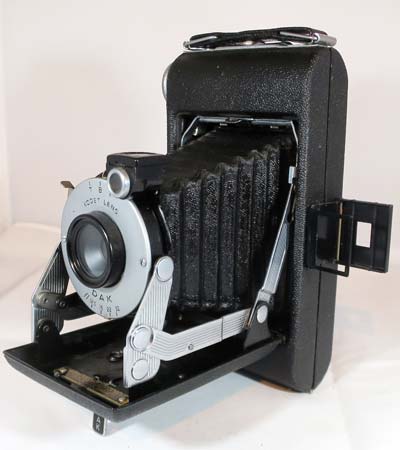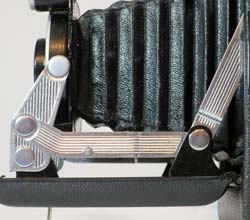Kodak Vigilant Junior Six-20
Specification

| Manufacturer | : | Kodak |
|---|---|---|
| Produced | : | 1940 |
| Classification | : | Medium Format |
| Body Type | : | Folding Bed |
| Bellows Deployment | : | Self Erecting |
| Construction | : | Metal |
| Film Type | : | 620 |
| Film Width | : | 62mm |
| ImageSize | : | 2¼ x 3¼ in |
| No. of Images | : | 8 |
| Lens Type | : | Kodet |
| Focus Type | : | Variable |
| Focal Length | : | 87mm |
| Focal Range | : | 4ft(f/32) 8ft(f/12.5) - inf. |
| Aperture Type | : | Iris |
| Aperture | : | f/12.5 - f/32 |
| Shutter Type | : | DAK |
| Shutter Speeds | : | T,B, I*(1/40) |
| Size Closed (w x h x d) | : | 95 x 165 x 40 mm |
| Size Open (w x h x d) | : | 120 x 155 x 130 mm |
| Weight | : | 726g |
Art Deco Credentials
![]()
![]()
![]()
Noteworthy: Worth giving special attention
- Produced during the main Art Deco period.
- Ornate chrome struts.
- Fine grain leatherette body covering.
- Concentric circles on chrome film winder.
- Curved body shape.
- Plain faceplate in contrasting colour.
- Chrome and black enamel brilliant finder.
Description

The Kodak Vigilant Junior Six-20 is a folding, self-erecting camera made in the USA and Canada by Kodak from 1940 to 1948. It took 6x9cm images on 620 film. It was similar to the Kodak Vigilant Six-20, but with a simpler lens and shutter. There was also a larger model, the Vigilant Junior Six-16. The curved body takes its style from the Streamline Moderne era.
This camera has a simple fixed focus Kodet meniscus lens in a Dak shutter. The camera also had the option of having a better 3 element Bimat lens with a fully adjustable f/11 to f/32 iris. It had a Dakon shutter with time, bulb, and 1/25s plus 1/50s exposure settings.
The camera has a single action type shutter with I, T and B settings. A remote cable release socket is provided. The five blade iris type aperture is variable between f/12.5 and f/32. It has both fold down eye level frame viewfinder and a waist level brilliant viewfinder. Two tripod sockets for both portrait and landscape orientation are available.
How to Use
A manual for this camera is provided here:- Kodak Vigilant Junior Six-20 manual.This camera takes 620 film which is still available from selected photographic outlets. Although the actual film is the same as 120 film, the spools are different. The 620 spools are slightly shorter and have a smaller diameter. Do not use 120 film in this camera because it will jam and may snap. It is possible to cut down a spool of 120 film to fit or to re-spool some 120 film onto 620 spools in a darkroom or changing bag.
As the shutter speed is only 1/40s, hold the camera firmly against your body to reduce shake. Using a tripod is a good idea. However, holding it against a wall or other solid object would work as well.
If you don't want to bother with an exposure meter, follow the guide shown. It is based on the 'Sunny 16' rule. Film is so forgiving and will produce acceptable results even when overexposed by 2 or 3 stops or underexposed by 1 stop.
The table assumes that the sun is at least 30 degrees above the horizon - that's 10am - 5pm on a summers day in the UK.
Remember that the exposure guide in the manual may not be helpful as it is based on the use of old film with a low ISO value.
Using ISO 100/125 film - shutter speed 1/40s
| Weather Conditions | Shadow Detail | Aperture | Exposure |
|---|---|---|---|
 Sunny SunnySnow/Sand | Dark with sharp edges | f/32 | Good |
 Sunny Sunny | Distinct | f/22 | Good |
 Slight Overcast Slight Overcast | Soft around edges | f/16 | Good |
 Overcast Overcast | Barely visible | f/12.5 | Good |
 Heavy Overcast Heavy Overcast | None | f/12.5 | -1 Stop Underexposed Acceptable |
 Open Shade Open Shade/Sunset | None | f/12.5 | -2 Stops Underexposed Not Acceptable |